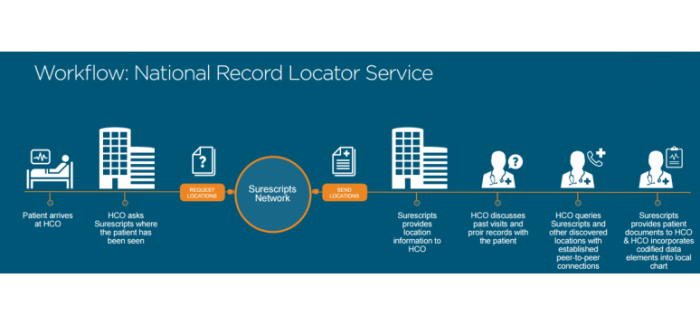US Medical Systems Becoming More Interoperable
Health information company Surescripts announced the nationwide activation of National Record Locator Service, which provides medical organizations with an effective way of getting a complete health history of any patient.
Now National Record Locator Service includes information about 140 million patients, it is connected with up to 700 HER (Electronic Health Record) apps and has up to 2 million transactions annually. Main partners of this standardization system are the largest medical systems manufacturers like CVS Health, Express Scripts, Epic and NextGen Healthcare. With the help of this service, medical organizations working on Epic Care Everywhere or NextGen Share software can identify patients’ data and exchange their medical records using various systems in different regions of the country.
Working on interoperable platforms Carequality, National Record Locator Service can easily integrate into any working processes of EHR systems and allows medical specialists to get a complete information about their patients. Thus, the service provides patients with the best treatment solutions.
The service can be determined as a system handling requests and inquiries, retrieving and exchanging electronic medical records; it is connected with network Surescripts and catalog Master Patient Index including 230 million patients. Doctors dealing with this service can not only look through clinical records but also find prescribed medicine with the help of its program Surescripts Medication History.
Surescripts also takes part in program Precision Medicine Initiative initiated by US president Barak Obama. In particular, the company provided its infrastructure to aggregate medical records of national research participants conducted by the National Institute of Health. The total number of participants involved in the research is 1 million.
The problem of interoperability of different information systems and devices has been an intense topic for discussion in medical as well as technological circles for quite a long time now. And lately, some important changes have happened. For instance, an initiative of improving the efficiency of electronic health records usage was announced at recently held conference HIMSS 2016. Five large suppliers of appropriate software such as Epic, Cerner, Athenahealth, Allscripts, Kaiser Permanente and John Hopkins Medical are going to contribute to this initiative. In its framework the companies promised to fulfill the tasks:
- provide users (patients) with a simple and secure access to their health records from any even the most distant part of the country and learn patients how to use this information
- do not block other providers allowing different providers to use medical data at the same time except cases provided by law
- start to create and establish national standards of interoperability, corresponding rules, instructions and guidance concerning it, adapt the best examples of interoperability despite the fact where they were developed
However, today the discussion of different aspects of interoperability is taking place rather separately: some companies deal with technical problems of its implementation, others handle standardization problems or its usability and simplicity for users.

